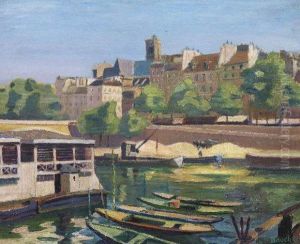Louis Daniel Bouchet Paintings
Louis Daniel Bouchet, born on September 16, 1806, in Vienne, France, and passed away on August 7, 1865, was a French landscape and portrait painter whose career flourished during the 19th century. Bouchet's contributions to art are often characterized by his meticulous attention to detail and his ability to capture the essence of his subjects, whether they be the grandeur of landscapes or the subtleties of individual character in his portraits.
Initially trained in Lyon, Bouchet later moved to Paris to advance his education and career. In Paris, he was exposed to the works of the leading artists of his time and was significantly influenced by the Romantic movement, which is evident in the dramatic expressions of nature and emotion found in his paintings. Despite the dominance of Romanticism during his formative years, Bouchet's work also displayed characteristics of the emerging Realist movement, which sought to depict subjects as they were, without idealization.
Throughout his career, Bouchet exhibited his works at the prestigious Paris Salon, the official art exhibition of the Académie des Beaux-Arts in Paris. His landscapes and portraits were well-received, earning him accolades and recognition among his peers. His ability to blend the Romantic interest in nature and emotion with Realist attention to detail and truthfulness in representation made his work particularly appealing to a diverse audience.
Bouchet's legacy, though not as widely recognized as some of his contemporaries, remains significant in the study of 19th-century French art. His paintings continue to be appreciated for their technical skill, emotional depth, and the insight they provide into the artistic transitions of his time. After his death in 1865, Bouchet's contributions to French art were celebrated, but over time, his name became less prominent in the annals of art history. Nevertheless, for those who study the nuances of 19th-century European art, Louis Daniel Bouchet represents a fascinating intersection of movements and a testament to the era's evolving artistic expressions.
